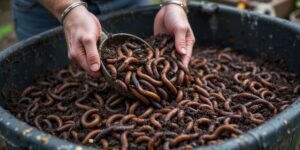Worm farming, or vermicomposting, is an efficient and sustainable way to recycle organic waste into nutrient-rich compost. However, when setting up a worm bin, you have to choose between different composting methods. Two of the most popular approaches are layering systems and continuous flow systems. Each has its own advantages and challenges, making it important to determine which one best fits your needs.
In this article, we’ll explore the differences between these two worm composting methods, their pros and cons, and which system is best suited for different users.
What Is a Layering System?
A layering system, also known as a stacked tray system, uses multiple bins or trays stacked on top of each other. Worms migrate upward to new food sources while finished compost remains in the lower trays, making it easy to harvest.
How the Layering System Works
- Start with a single tray filled with bedding and worms.
- Add food scraps regularly, covering them with additional bedding.
- Once the first tray is full, add a second tray with fresh bedding and food.
- Worms naturally migrate upwards to the new tray.
- Once worms have moved up, the bottom tray contains finished compost, which can be removed.
Pros and Cons of Layering Systems
| Advantages | Disadvantages |
|---|---|
| Easy compost harvesting – finished compost is separate from worms | Limited capacity – may not be suitable for large-scale composting |
| Space-efficient – stacked design maximizes vertical space | Requires monitoring – worms must migrate to new trays properly |
| Minimal disturbance to worms | If neglected, old food may rot before worms migrate |
Layering systems are ideal for small households, apartment dwellers, or those with limited space.
What Is a Continuous Flow System?
A continuous flow system allows worms to process food scraps continuously without the need for stacking trays or manual migration. The composting material moves downward naturally, and finished compost is removed from the bottom while fresh food is added to the top.
How the Continuous Flow System Works
- Worms and bedding are placed in a deep bin.
- Food scraps are added regularly to the top layer.
- Worms stay near the surface, where fresh food is available.
- As material decomposes, finished compost accumulates at the bottom.
- Compost is harvested by removing material from the bottom of the bin.
Pros and Cons of Continuous Flow Systems
| Advantages | Disadvantages |
|---|---|
| Easier to maintain – no need to transfer worms to new trays | More difficult to separate worms from compost |
| Handles larger amounts of waste – ideal for high-volume composting | Can be bulky – requires more space than stacking systems |
| Reduces disturbance to worms | Requires proper moisture balance to prevent compaction |
Continuous flow systems are best suited for outdoor setups, larger-scale composting, or users who want a low-maintenance system.
Layering vs. Continuous Flow: Which One Should You Choose?
Choosing between a layering system and a continuous flow system depends on several factors, including available space, waste volume, and maintenance preferences.
Comparison Table
| Feature | Layering System | Continuous Flow System |
|---|---|---|
| Best for | Small-scale composting | Large-scale composting |
| Space efficiency | High – vertical stacking saves space | Lower – requires more surface area |
| Ease of harvesting | Easier – finished compost is separate from worms | Harder – worms may be mixed with compost |
| Worm migration | Required – worms move to upper trays | Natural – worms stay near the top |
| Composting speed | Moderate | Faster due to continuous feeding |
| Maintenance level | Medium – requires monitoring of trays | Low – requires minimal intervention |
Tips for Success in Any Worm Composting System
Regardless of which method you choose, follow these best practices to ensure a successful worm farming experience:
- Maintain proper moisture levels – Keep the bedding damp but not soaked.
- Avoid overfeeding – Only add food scraps when previous waste has been processed.
- Choose the right worms – Red Wigglers (Eisenia fetida) are the best choice for composting.
- Provide proper aeration – Regularly fluff bedding and ensure bins have ventilation holes.
- Harvest compost at the right time – Remove finished compost before it becomes too compacted.
Conclusion
Both layering systems and continuous flow systems offer effective ways to compost organic waste using worms. If you have limited space and prefer an easy-to-harvest system, a layering system may be the best choice. On the other hand, if you generate large amounts of organic waste and want a low-maintenance setup, a continuous flow system is likely the better option.
Consider your available space, composting needs, and level of involvement before choosing the best worm farming method for you. Whichever system you use, worm farming is a rewarding and environmentally friendly way to recycle organic waste into rich compost for your garden.




